Advantage Prost
Another silky drive by the Frenchman restored his World Championship lead, but things weren’t quite so smooth off the circuit…
How long is it since Ayrton Senna qualified as low as eighth for a GP? It was a question many were mulling over just before the start of the Canadian GP, as the Brazilian and McLaren tried to put behind them an awful two days of qualifying in which the MP4/8s were in dire handling trouble. In fact, it was so bad that nobody was really placing bets on him having much of a chance in the race either, except perhaps McLaren personnel who, after the morning warm-up, knew a thing or two. The Williams Renaults of Prost and Hill had dominated practice, and to make matters more interesting Schumacher and Patrese had lined their Benetton Fords up third and fourth ahead of the improving Ferraris of Berger and Alesi. Even Martin Brundle had snuck his Ligier Renault ahead of the McLaren Ford.
When the Sunday morning warm-up produced times in the 1m 23s bracket for Prost, Schumacher, Hill and Alesi a ripple of anticipation crept down the pit lane, and the start of what is a notoriously hard race on cars and fuel consumption was eagerly awaited. Throw in Prost’s start ‘problem’ in Monte Carlo, and there was an added nuance. Would he be nervous?
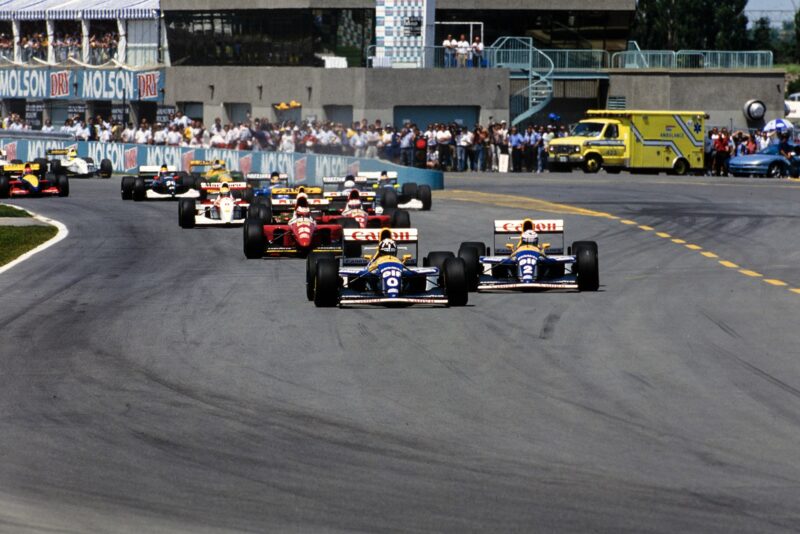
Damon Hill leads team-mate Alain Prost into the first corner
Motorsport Images
The man himself almost laughed at the suggestion, having made just a few GP getaways in his career and in any case figuring Monaco’s had been one of the best of them.
When the Canadian GP got underway Hill and Prost entered the braking area for the first corner side by side, with Alain conceding the advantage to his team-mate. Any worries there had proved unfounded. Behind them, though, Schumacher had made a lousy start, Berger and Alesi had outfumbled Patrese… and Senna was already piling up into fifth place, round the outside of Schumacher in the left-hander so that he had the inside line for the tight right that follows. It looked like Donington all over again…
Overnight McLaren had refused to give up, and had persisted with processing all of its data until Neil Oatley and his crew had come up with a set-up that really worked. It was an impressive recovery, by any standard, and another indication why McLaren can justly lay claim to be one of the best two racing teams in F1. Senna had a car that worked again, and he was in the mood to run.
Alesi, bless him, tried all he could to resist in a Ferrari now equipped in a race with the more powerful TT variable inlet trumpet engine tried by Berger in Monaco. Like the man after whom the St Lawrence River circuit is named, Jean refused to give up and gave Senna some anxious side-by-side moments before power and handling superiority finally told on the opening lap, and then Berger succumbed just a lap later.
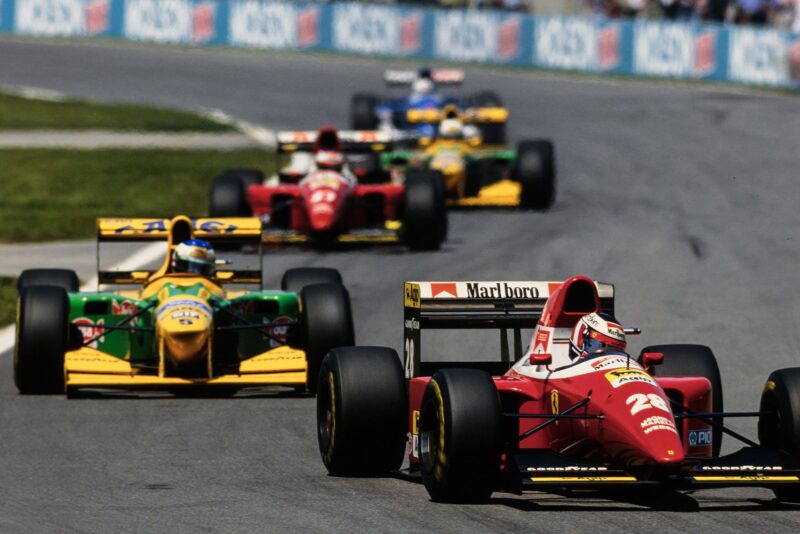
Gerhard Berger ahead of Michael Schumacher, Jean Alesi and Riccardo Patrese
Motorsport Images
“I thought I might have had the chance to overtake at least one of the Williams drivers at the start,” Schumacher said of his disastrous departure. The latest version of the Benetton B193B had looked nimble all through qualifying and would not need to carry as much fuel to the line as the Renault-powered machines. “But the start went terribly wrong,” he continued. “Due to a problem with the traction control adjustment I nearly stalled twice…”
Even worse off was poor Michael Andretti, who had been wheeled off the grid on the formation lap because his McLaren had died. “There was some sort of short circuit in the jump start battery, and it just sucked the life out of Michael’s car,” said Ron Dennis. “You just can’t restart it because you have to reactivate things, and change some things, and that takes time.”
Andretti lost three laps before getting underway and putting in a very vigorous drive that would ultimately yield a disappointing 14th place when third or fourth might have been on the cards. “Another nightmare!” he grimaced. “I just got stuck in and tried to work my way back up, but it was hard to overtake.”
In the opening laps Hill was setting fastest laps with Prost in pursuit, but sportingly let his team-mate by at the hairpin on lap six. Prost immediately began to draw away, responding to pressure from the amazing Senna as Ayrton then began to home in on the Englishman. Berger was fourth from Alesi, who had Patrese, Brundle and the two Saubers too close for comfort.
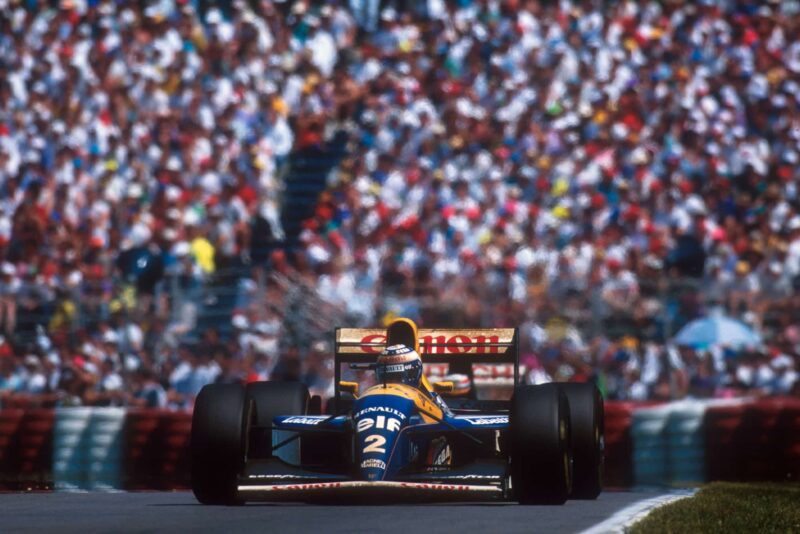
Alain Prost in a rather dirty-looking Williams
Motorsport Images
Some teams figured they might be able to make it through non-stop, and indeed Comas for Larrousse and Fittipaldi for Minardi did just that while enjoying a see-saw battle that would eventually reap them deserved eighth and ninth places. Williams strategy, however, was for both drivers to push as hard as they could, and to keep up the pressure and stop for fresh rubber rather than later having to try and conserve Goodyears long past their best. Senna pushed hard after Damon for a long time, but the Englishman had things stabilised as they began to consider their tyre stops around the 29 lap mark. That was when it went wrong for Hill.
Of the front runners, Schumacher was the first to stop, on lap 29. The German had battled his way by Patrese on lap two, Alesi on lap three and Berger by lap six, and thereafter chased as hard as he could after the fleet Senna. He called in for his Goodyears and left still in fourth place, but when Damon came in the next time round there was one of those awful Fred Karno stops that Williams sometimes suffers. The team had been expecting Prost, and had no tyres immediately at hand for Damon. “I must admit, I was surprised to see the mechanics rushing round for them,” he said diplomatically afterwards. It was a long, long call, and by the time he got out again he had dropped to fourth.
Senna came in on lap 31, and McLaren got him out in a fantastic 4.6s so that he didn’t lose a place, but Prost kept out much longer. The race leader finally called in on lap 34, and he too made it out without surrendering his position.
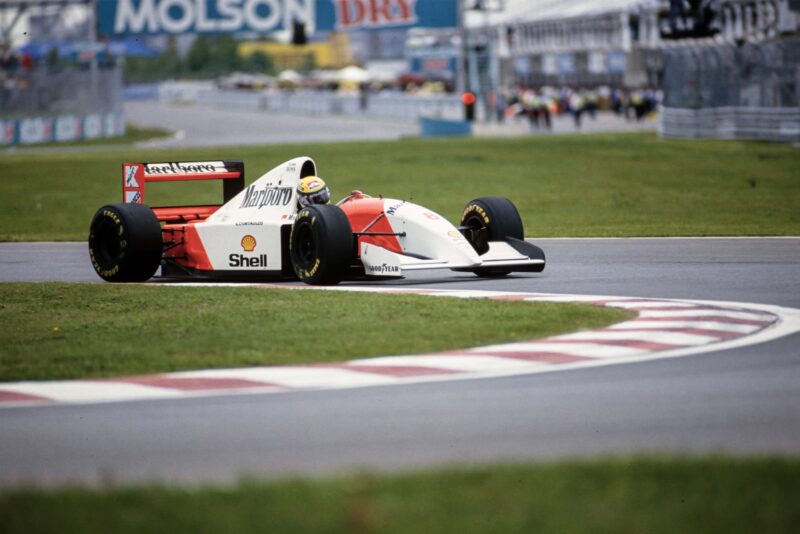
Ayrton Senna in his McLaren
Motorsport Images
Back down the field, Berger’s stop on lap 30 had let Patrese into fifth place, for Alesi had long since departed with engine failure after taking that place from Gerhard on lap 16 as the Austrian ran into a brake problem. “The balance of the car was good,” said Jean, “and the variable length inlet trumpets worked well on the TT engines. I had settled into a nice rhythm when I saw the water temperature going up. After a while the engine broke…” A joint in a coolant pipe had sheared.
Berger’s stop was very quick too, so he was surprised to find himself still behind Riccardo once the Italian had come in on lap 32, but it was mighty close. Riccardo just got out of the pit lane exit and into the first corner before Gerhard had the chance to go barrelling by him. Brundle, too, was right there after his stop on lap 31, so after hounding Riccardo early on while resisting pressure from Wendlinger, team-mate Blundell and Lehto, Martin was again pushing for sixth place. Mark, however, had gone on lap 14. “I made a mistake trying to hold off Lehto,” he said in a voice laden with self-disgust. “He was quicker than me in the early laps, and I just lost control.”
Wendlinger ran as high as fifth by dint of not stopping until lap 37, the longest of all, whereupon he temporarily fell behind JJ and into ninth place. JJ had figured it the perfect moment to pit on lap 27 when he’d closed right up on, but couldn’t pass, his teammate. Thereafter his C12 felt really strong, but it lost third and then second gear with 20 laps to go, so Karl repassed. Wendlinger himself would have trouble, for fourth, fifth and sixth began jumping out with five laps left, but he nursed the black car home for his first point for the Swiss/German team.
Patrese’s race was interrupted on lap 44 when he spun under pressure from Berger, pitting for a new nose before resuming in 12th place, but the reason for the rotation was cramp which was deadening his right leg. “This place always gets you like that,” agreed Hill. “I was losing the feeling in mine because of all the braking you do here.” Riccardo struggled on for another nine laps before feeling obliged to quit.
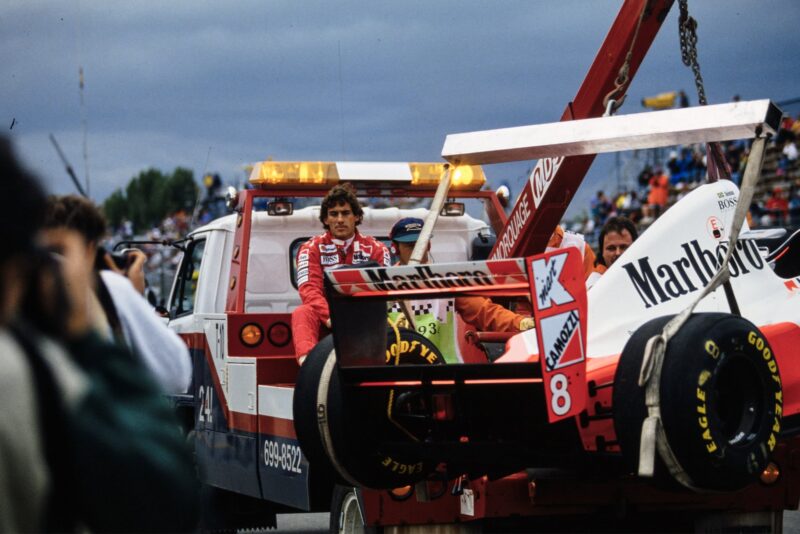
Senna looks on as his McLaren is towed away
Motorsport Images
In the closing stages Schumacher stealthily began to progress towards Senna, having taken care of his new tyres and maintained the gap between them at four to five seconds. Then he really began to push hard. From 3s on lap 56 the gap was halved two laps later. Then they were nose-to-tail. Before we could determine whether Senna was in trouble or Schumacher was simply catching him, the McLaren did hit a sudden problem on lap 63, and as Ayrton pulled to the right to give him room, Michael chose that moment to dive that side of the MP4/8. “We nearly touched,” said the German breathlessly, and indeed initial reports suggested that he might have repaid the Brazilian for South Africa. It was nothing like that, though. “We saw the alternator on Ayrton’s car begin to fail on the telemetry 30s before he retired,” said Ron Dennis. “When it went on the blink it then drained the battery and cut everything out. What with Michael’s problem at the start and then this, after we’d worked so hard to get the cars sorted for the race, it was a real double whammy. Especially as Ayrton thought he had everything under control.” The failure was similar to one Michael had experienced in the morning warm-up.
That left Schumacher to chase Prost home, with Hill unable to offer a challenge in third place. “We’ve made a big step with the car and after the disappointment of Monte Carlo, we were able to show our potential here,” beamed the Benetton driver. “Coming back from seventh to second for the second year running is almost as good as a win for us.”
“The engine was sounding a little different towards the end,” said Damon, “so I decided to get the car to the finish. The temperatures didn’t suit our car as much as they should have done.” He pondered the Benetton’s performance, and added reflectively: “I pushed quite hard but I could not quite push hard enough on the Benetton. They have improved it quite a bit.”
Berger was happy enough with fourth, since he was tight on fuel in the closing stages, but poor Brundle lost out lapping the Badoer/Warwick fight and lost vital ground just when he seemed ready to challenge. “I was flat out all the way,” grinned Marty. “I really couldn’t have gone any quicker to attack Berger, but our aerodynamic modifications allowed me to keep in touch, which was very difficult before.”
Like Hill, Prost was reflective as he considered the Benetton performance. “You know, the gap between us and the opposition was much bigger in qualifying but after the warm-up I was surprised how much closer they were. Proof of that came when I had to push hard all the time…” That augured well for the remainder of the season, which is more than could be said for the politics in Montreal.
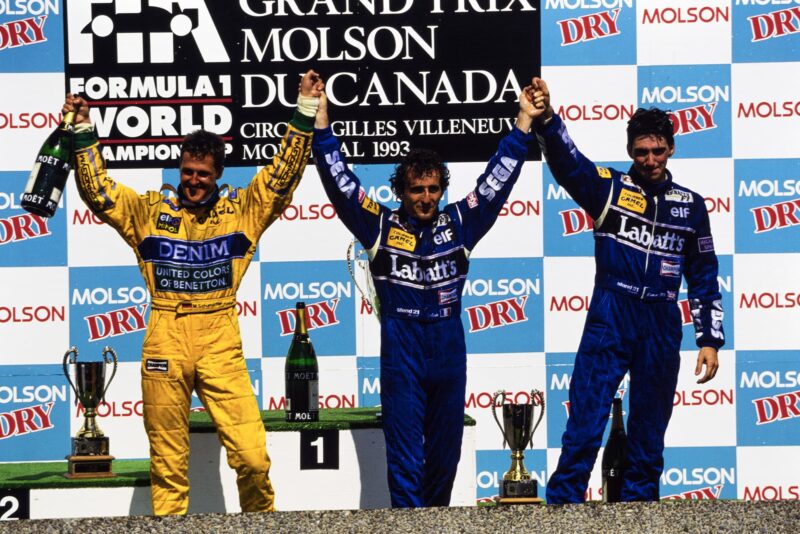
Prost, Schumacher and Hill celebrate on the podium
Motorsport Images
For Prost a first ever victory in Canada tasted sweet, but there were sour tastes in the paddock on Saturday when the F1 Technical Delegate Charlie Whiting and the FISA stewards filed a report to their masters claiming that all but the Scuderia Italia Lola Ferraris contravened either the rules governing movable aerodynamic devices (via their active suspension) or the methods by which a driver controls his engine’s power (via traction control).
It was, of course, all part of newly elected FIA President Max Mosley’s express wish to get rid of all technological aids for the 1994 season, and this ridiculous outburst was seen as a method of warning angry entrants Frank Williams and Ron Dennis – who have made massive investments for future research and development programmes – that they needn’t bother threatening to take FISA to international law for breaking the Concorde Agreement when the teams themselves were already breaching technical regulations. Nowhere along the line did FISA say why active cars and traction control have been allowed for the past 18 months or more if they were illegal, and cynics of course, such as ourselves, started to drag out Max’s quotes – made to Motor Sport this time last year – to the effect that technology should be allowed to have its head.
If it wasn’t all so silly it would be laughable, but sadly the only laughter in North America where F1 is so desperate to establish itself again and where none of the natives really cares was aimed at F1. It came from the IndyCar race in Detroit and the NASCAR event at Pocono. D J T
